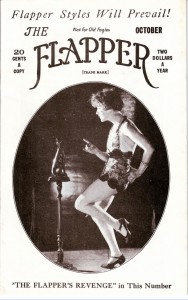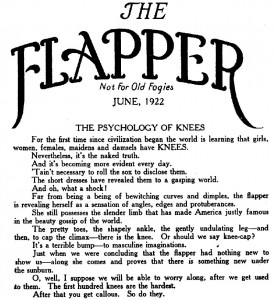 This is why patronizing your local used bookstore is so vitally important, because nobody’s digging through piles of weird old mildewy tomes in the Amazon warehouse and squealing with delight when they come across a stack of Flapper magazines (not for old fogies) from the 1920s. Okay, I may be projecting a little there. I don’t know if Jim Lewin of the Bookflaps blog and The York Emporium used bookstore actually squealed when he found the near-mint lifestyle magazines of the fast-car, bathtub-gin, Charleston-dancing party girls of the Jazz Age, but he probably did on the inside at least.
This is why patronizing your local used bookstore is so vitally important, because nobody’s digging through piles of weird old mildewy tomes in the Amazon warehouse and squealing with delight when they come across a stack of Flapper magazines (not for old fogies) from the 1920s. Okay, I may be projecting a little there. I don’t know if Jim Lewin of the Bookflaps blog and The York Emporium used bookstore actually squealed when he found the near-mint lifestyle magazines of the fast-car, bathtub-gin, Charleston-dancing party girls of the Jazz Age, but he probably did on the inside at least.
The magazine’s mission is downright feminist:
“What the FLAPPER stands for: short skirts, rolled sox, bobbed hair, powder and rouge, no corsets, one-piece bathing suits, deportation of reformers, non-enforcement of Blue Laws, no censorship of movies, stage or the press, vacations with full pay, no chaperons, attractive clothes, the inalienable right to make dates, good times, [and] honor between both sexes.”
Rock on, sisters! (Please to observe the Flapper cover girl above right making the appropriate “rock on” gesture long before Ronnie James Dio was a twinkle in his father’s eye.)
One of the issues contained a glossary of Flapper slang that is so truly exquisite, I intend to make every effort to memorize it all and speak only in Flapperese from now on.
The July 1922 edition of Flapper contained “A Flapper’s Dictionary.” According to the uncredited author, “A Flapper is one with a jitney body and a limousine mind. The Shifter is a new species who flaunts as his banner, “Something for nothing and then very little.”
“The flapper movement is not a craze, but something that will stay,” the author maintained. “Many of the phrases now employed by members of this order will eventually find a way into common usage and be accepted as good English.”
 That turned out to be an unfulfilled prophecy, I’m sad to say, although a few of the phrases have indeed become part of our lexicon. Bee’s knees, cat’s pajamas, blaah, dogs (meaning feet), and ducky (describing something good) are all still in common parlance. “A jitney body and a limousine mind” do not appear in the dictionary, but if we take the vehicular metaphors at face value, it’s actually quite racy. A jitney was a small bus that charged only a nickel for passage, while of course a limousine is a big fancy expensive car. I guess that makes a flapper a cheap ride with an expensive wit.
That turned out to be an unfulfilled prophecy, I’m sad to say, although a few of the phrases have indeed become part of our lexicon. Bee’s knees, cat’s pajamas, blaah, dogs (meaning feet), and ducky (describing something good) are all still in common parlance. “A jitney body and a limousine mind” do not appear in the dictionary, but if we take the vehicular metaphors at face value, it’s actually quite racy. A jitney was a small bus that charged only a nickel for passage, while of course a limousine is a big fancy expensive car. I guess that makes a flapper a cheap ride with an expensive wit.
Here are a few choice entries from the dictionary that are in desperate need of revival:
Brush Ape—Anyone from the sticks; a country Jake.
Dingle Dangler—One who insists on telephoning.
Noodle Juice—Tea.
Nosebaggery—Restaurant.
Strike Breaker—A young woman who goes with her friend’s “Steady” while there is a coolness.
Trotzky (sic)—Old lady with a moustache and chin whiskers.
Wurp—Killjoy or drawback.
I found a few scans of articles from Flapper magazine on Old Magazine Articles’s excellent website, but the dictionary is not among them. A highly amusing pro-knee manifesto (pdf) is, however, and yet again, it concludes with what looks to me like quite a raunchy bit of innuendo.

See what I mean? The knees get calloused after the first hundred what, exactly? Also lol @ something new under the sunburn.
If you wish to immerse yourself further in the world of biscuits and sheiks, you simply must check out Carrie, a ’20s comic strip by Wood Cowan that follows the adventures of stylin’ flapper girls and the men they use for their entertainment.

I hate seeing an entry with no comments, so here is a comment on your entry.
I wonder how much the Great Depression but the brakes on feminism, if indeed the flappers would have led to long lasting social change. Obviously, the Women’s Movement had existed prior to this, but in a more political form, with the suffragettes and the temperance movement.
Also, you are a goop.
I suppose the conflict of the sexes is who is the entertainment, the flapper or the men in their company….
That is an interesting perspective. Maybe they both are and just don’t know it! 😆
The first comment made an interesting observation. The great Depression did, indeed, put a temper in the feminist movement. And not just the feminist movement. In popular culture in general. (Ever really listen to 20s music? I mean, 20 pop music like jazz? It’s really awesome stuff!)
There was still some good music come out of the 30s, but for two, almost three long decades, there was a drought in, not just music and the entertainment industry, but in the civil rights and feminist movements as well.
It wasn’t until the 60s, after the Great Depression and World War II, and a conservative backlash, that both the entertainment world and the civil rights movement came out full-swing.
I don;t find it a mere coincidence when a society has increased creativity, there to, you will find increased freedoms and fights for social justice, for many people.
Excellent article!
Since 1776, there were exactly two times when Americans—particularly women—were truly happy and free: 1922-1927 and 1967-1968.
As a sex-positive feminist (a la Paglia), I study those times. I also study the negative curvature of 4D hyperbolic pseudometric spaces specifically so I can invent a time machine and visit Harlem in the 20s and ‘Frisco in the 60s.
…Though 13 year-old girls texting full-frontal naked pix to boys in their class as a way of introducing themselves IS pretty cool.
AMAZINGLY, fourteen percent of 13 year-old girls have done that. There IS hope for the future.